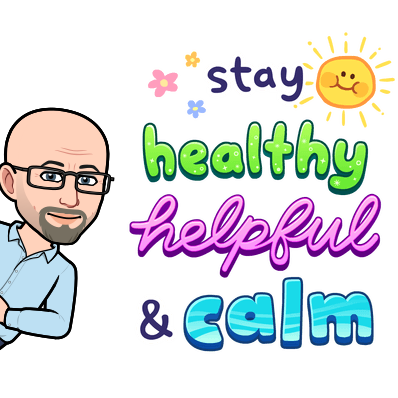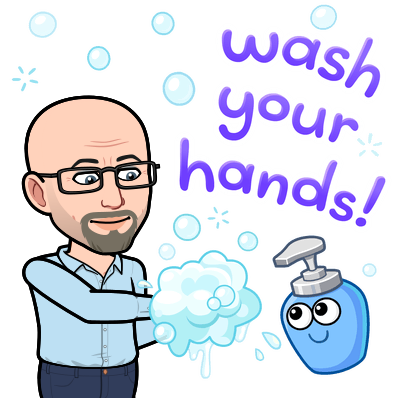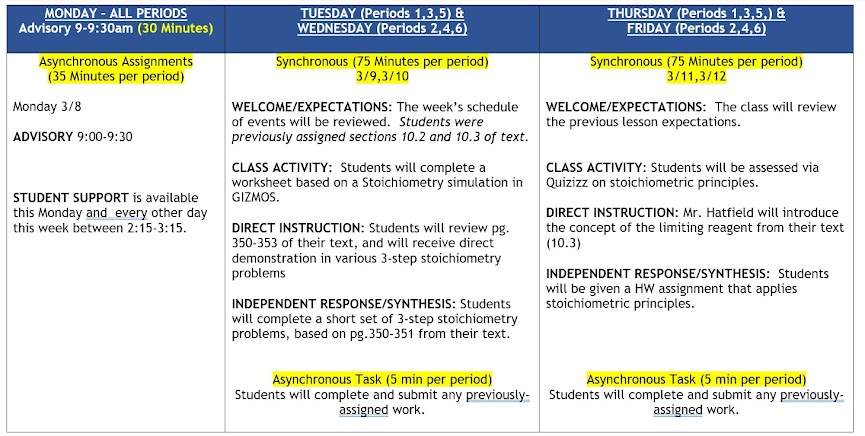Wednesday, October 20, 2021
POWER POINT NOTES: ELECTRON CONFIGURATION 2021
Students should use this to complete the Study Guide for next Tuesday's test (10/26), and along the way make sure that everything in the Study Guide does, in fact, appear in their notes inside their Composition Book.
Wednesday, October 6, 2021
HOW TO 'C.O.P.E.' WITH MR. HATFIELD'S TESTS
On Tuesday, September 28th, Mr. Hatfield's students began taking their first Unit Test in Chemistry.
The first test can be thought of as a 'lesson' on what to do, and what not to do. Until students see the test for themselves, and know what it is like, it's difficult to prepare for.
Students who earn a percentage score higher than that earned on the first test can not only expect to earn a higher grade, but they are eligible for grade change on their previous test.
To achieve that, students need to consider the following, using the anagram 'COPE'.
C....(ontent)
Students need to know what's on the test.
O....(rganization)
Students need to plan their time.
Students should consider forming Study Groups with fellow students, perhaps after school on the day before the exam. They earn points by attending, and get valuable feedback about what is likely to be covered. Students need to consider using time on lunch or after-school on the day of their exam as needed to complete their test. Plan ahead, students!
P...(reparation)
Students need to provide evidence that they have prepared for the test.
One way to do this is to attend Study Hall during lunch, before the next test. Another, powerful way is to make sure that they bring their COMPLETED NOTES to class on the day of the exam, inside their Lab Composition Book. To aid Students in completing their Notes, Mr. Hatfield makes them available on-line through this blog and gives a Study Guide for Students to complete to demonstrate that they have the Notes, and know what to do with them. Bring evidence that you have prepared for the test, students, and you will be rewarded!
E...(ffort)
Students need to finish what they start.
There is nothing more important than giving our best effort, all of the time. On an exam day, a good effort means that students attempt everything, even if that means they need to come back at lunch or after school. Show a work ethic, students, and you will not only do better on the test....you will do better in every aspect of your life.
PARENTS, ENCOURAGE YOUR STUDENT TO USE THESE STRATEGIES TO EXCEL!
Tuesday, October 5, 2021
VIDEO: FIREWORKS!
The worksheet for this video can be obtained HERE.
Students should pay careful attention to TWO topics:
Monday, October 4, 2021
VIDEO: THE FLAME TEST
Here is a video that shows much the same sort of observations students made on Monday. Unfortunately, it is not practical to 'make up' this particular lab. Watch the video, students, and compare it with observations that students who attended were able to make in order to understand the material:
Friday, October 1, 2021
VIDEO: BRIGHT LINE SPECTRUM CALCULATIONS
In this VIDEO, Mr. Hatfield models calculations that allow students to determine the frequency and the energy of a particular light wave seen in spectroscopy, as discussed in Section 4.2 of our text, and as seen in the Bright Line Spectra Lab.
BUT JUST AS IMPORTANT, Mr. Hatfield AGAIN models the use of a notation for displaying very large or small numbers that mimics with the 'EE' key found on many scientific calculators.
This method was previously taught in class. It is a SUPERIOR method that saves time, reduces the likelihood of student error and has students writing out these numbers in a form that matches the way they enter those numbers into a calculator!
And, since students will continue to use that method for the rest of the course, it is important that students master the use of that method for future success.
Wednesday, September 29, 2021
VIDEO: THE BUNSEN BURNER
Mr. Hatfield has made a video to demonstrate the correct way to use the Bunsen burner. Make sure you review this before you come to class on Monday, as we will be using the Bunsen burners in class to perform the 'Flame Test Lab'.
Monday, September 27, 2021
VIDEO: RED TAPE ON THE FLOOR
Some students have suggested that I should do more about my aging, overcrowded classroom. They think I should raise a complaint, and get people to understand how rooms like mine make it difficult for students to achieve.
Well. I can't say that my students are wrong on that point. Our situation's not that great, I admit.
But this situation is also something that's definitely in my wheelhouse, as this video from the summer of 2020 should show:
Friday, September 24, 2021
VIDEO: A QUICK LOOK AT THE PARTS OF THE ATOM
This video from Pearson is intended to accompany Investigation 4 in our textbook:
Thursday, September 23, 2021
POWER POINT: THE PERIODIC TABLE
Students: HERE is the latest set of Power Point Notes.
Click on the link or the graphic above to go to a Mediafire page, where you can download the Notes.
Monday, September 13, 2021
VIDEO: DRAWING ATOMS, "HATFIELD STYLE"
In THIS video, Mr. Hatfield demonstrates his cartoony, unrealistic way of drawing atoms, where '+' are protons, '0' are neutrons and 'e-' are electrons.
Every attempt to draw an atom is, in some sense, unrealistic: after all, atoms are smaller than the waves of visible light which our eyes use to form images. In a sense, atoms don't look like ANYTHING.
Yet, while unrealistic, mastering the use of these symbols can help students develop a better understanding of atomic structure, which can be applied to ions and isotopes as well as neutral atoms.
Friday, September 10, 2021
POWER POINT: THE FLAVORS OF MATTER
Students: HERE are the Power Point Notes on 'The Flavors of Matter', as shared in class between Aug. 31 and September 9th.
Please note that the final slides not only demonstrate how to write nuclear notation to show isotopes, but that it contains an image of that notation with 'atomic drawings, Hatfield-style', as shown in class and shared on Teams.Tuesday, August 31, 2021
UNIT CONVERSION, STEP BY STEP
The attached graphic models (again!) the steps involved in unit conversion, as taught in class. If you haven't mastered the method, download the graphic:
Thursday, August 26, 2021
VIDEO: EXPERIMENTAL DESIGN AND SIGNIFICANT FIGURES
Students: here is a new VIDEO that introduces a concept that you must ALWAYS employ when performing calculations in Chemistry.
Well-designed experiments take place in controlled conditions that account for variables, and which express their results in significant figures in order to handle the inevitable limitations to measurement that will occur.
When we do math in this course, we are NOT engaged in an abstract exercise in which the answer is simply a number for someone unknown variable, 'x'. Instead, we are attempting to measure real phenomena and make predictions about what these phenomena will produce in the real world.
In that real world, there are limits to the ACCURACY and the PRECISION of our measurements. Students must understand the difference between the related but distinct concepts! Students must understand that the limits require us to not express our results with an UNREALISTIC level of precision, that was NOT actually observed!
Monday, August 23, 2021
POWER POINT: THE NATURE OF CHEMISTRY
Students: HERE is a link to where you can get the Power Point, 'The Nature of Chemistry', which is used to help complete the Study Guide of the same name:
Remember: that Study Guide is a relatively-easy Assignment given to streamline the process of note-taking in this course. You want to complete every part of it and hand it in as soon as possible, as it will be graded and returned to you in order that you can create your complete, detailed Notes inside your Composition Book:
You are not allowed to use the Study Guide on the Unit Test, but you ARE allowed to use your Composition Book, so this is really a very important routine that you must maintain in this class. Make sure you do!Friday, August 20, 2021
WELCOME BACK! THIS IS CHEMISTRY!
Students, my name is Scott Hatfield, and I will be serving as your Chemistry Instructor in the 2021-2022 school year.



We live in interesting times, in a world of unexpected challenges.
In our case, the most obvious challenge is working together at school to create a safe environment that supports all students.
To help support you, I've created a virtual classroom page that has built-in links to supporting materials and important information that you would want at your fingertips:
I've also begun setting up our individual classes, and when you go looking for them on Teams, I hope they'll be easy for you to find, and even FUN for you to use!
Monday, May 31, 2021
Wednesday, May 19, 2021
VIDEO: EQUILIBRIUM CONSTANTS
In this VIDEO, Mr. Hatfield uses the whiteboard to demonstrate how to calculate the equilibrium constants for strong and weak acids, and also how to rearrange the equilibrium setups to solve for the concentration of products or the original acid's concentration.
Monday, May 17, 2021
Wednesday, May 12, 2021
VIDEO: ACID-BASE EQUILIBRIUM
This VIDEO contains useful demonstration of titration, the subject of our next set of Lab Activities, as well as models how to evaluate an equilibrium setup of a chemical system involving acids and bases.
Tuesday, May 11, 2021
VIDEO: NOTES ON ACIDS, BASES AND SALTS
This VIDEO contains Mr. Hatfield's notes on the current unit, based on Sections 15.1 and 15.2 of your text.
Topics include: water's polarity, hydrogen bonding, the dissociation of water, properties of acids and bases, indicators and titrations, the pH scale, acid-base definitions, salts and buffer solutions.
Monday, May 10, 2021
VIDEO: NORA FLANAGAN
Nora Flanagan is a sophomore English teacher in the Chicago public schools system. In this 'TED Talk' delivered last summer at Wrigley Field during that phase of the global pandemic, she identifies some ongoing problems with the public schools there were present before the pandemic.
Much of what Ms. Flanagan describes are also challenges for Fresno public schools, and so her talk is highly-relevant to what we have experienced and continue to experience as teachers, students or parents in the midst of a global pandemic.
She makes four specific recommendations: "We can and we must engage parents, demand equity, support the whole student and rethink assessment."
The full text of Ms. Flanagan's remarks are available on-line, HERE. As your instructor, I want to encourage all of my students to reflect on her remarks, particularly her comments on how we support the whole student, and whether we consider the student's voice:
"IF WE ARE HAVING CONVERSATIONS ABOUT ANY OF THIS, AND NOT AUTHENTICALLY INCLUDING AND EMPOWERING STUDENTS EVERY STEP OF THE WAY, WE'RE NOT HAVING CONVERSATIONS ABOUT ANY OF THIS."
Friday, May 7, 2021
VIDEO: ACID BASE INDICATOR DEMONSTRATION
In this VIDEO, Mr. Hatfield demonstrates the use of 'universal indicator solution' , as a means of comparison with the pH indicator strips used in the "pH of Solutions Lab" performed in class between May 5-12.
Unlike the lab, where we simply estimate pH from color changes, in this demonstration Mr. Hatfield goes back and forth, first adding positive charge (an acid), then negative charge (a base).
This is essentially a series of neutralization reactions swinging back and forth around pH 7 (neutral), and similar in concept to the titrations that will be the subject of our next set of Lab Activities.
Monday, May 3, 2021
Monday, April 26, 2021
VIDEO: HEAT OF SOLUTION LAB (ANALYSIS)
In a previous lab, Mr. Hatfield walked students through the steps needed to collect data in the 'Heat of Solution' Lab.
In this VIDEO, Mr. Hatfield explains how students will analyze the data from this Lab for two reactions, one exothermic and the other endothermic.
Students will then use Q =mCdT to find the energies (q) for both reactions in Joules, then discuss how those energies can be used to find the enthalpy of reaction, where dH (delta H) = -(q) / mol
Sunday, April 25, 2021
VIDEO: TUTORING SUPPORT AT BULLARD HIGH SCHOOL
In this VIDEO, Bullard High staff shares how students can access different kinds of tutoring support during the spring 2021 semester:
Wednesday, April 21, 2021
VIDEO: HEAT OF SOLUTION LAB
In this VIDEO, Mr. Hatfield walks students through the protocols and procedures of the 'Heat of Solutions' lab, which uses calorimetry to measure temperature changes ('delta T') in water based on chemical reactions involving sodium hydroxide or ammonium chloride:
Monday, April 19, 2021
WEEK 14 AT A GLANCE
Students: here is your 'Week At A Glance' for Week 14 of instruction in our Chemistry classes.
I also want to say that, due to the unexpected and difficult-to-anticipate demands of 'Simultaneous Instruction', be advised this is a VERY general plan.
When attempting to do a Lab in the physical classroom, there is a very different experience for in-person learners vs. distance learners, but we want to make sure we are working to promote EQUITY.
So, to make sure that all students have an opportunity to take part in an actual lab experience, we may have to either make opportunities available during Student Support, or shuffle the times required in scheduled class periods. This is my pledge to all of you.
Tuesday, April 13, 2021
'WELCOME BACK' INFORMATIONAL VIDEO
STUDENTS: I'm sharing a link for the 'Welcome Back' informational video, which will also be shown during during Advisory Period next Monday. You can view the full video online at your convenience as many times as you like, HERE:
Monday, April 12, 2021
WEEK 13 AT A GLANCE
Students: here is your 'Week At A Glance' for Week 13 of instruction in our Chemistry classes.
I also want to say that, due to the unexpected and difficult-to-anticipate demands of 'Simultaneous Instruction', be advised this is a VERY general plan, and we may need to make serious tweaks to the plan as we go along in order to provide equitable opportunities for all learners.
Thursday, April 8, 2021
REVISED BULLARD SCHEDULES: 'SIMULTANEOUS LEARNING'
I'm providing some illustrations here to assist students as we make the transition to 'Simultaneous Learning', where some cohorts of students (A, B) will spend some days as distance learners and other days as in-person learners, while other cohorts are either full-time distance learners (C) or full-time in-person learners (D).
This week, freshman and seniors will make that transition. Next week, sophomores and juniors will be found in all cohorts, as well. The first graphic makes the differences between Week 13 and Week 14 of the spring semester clear:
Monday, April 5, 2021
Sunday, April 4, 2021
STUDENT SUPPORT AND TUTORING
STUDENTS: Mr. Hatfield will continue to offer STUDENT SUPPORT at 2:15-3:15 throughout the rest of the semester. You may attend that everyday it's offered if you like.
Monday, March 22, 2021
WEEK 11 AT A GLANCE
STUDENTS: Here is our latest 'Week At A Glance" for Chemistry.
Please NOTE: Due to District Teacher Trainings and proximity to Spring Break, STUDENT SUPPORT is only offered on Tuesday and Wednesday of this week.
Tuesday, March 16, 2021
Saturday, March 13, 2021
VIDEO NOTES: CHEMICAL REACTIONS AND STOICHIOMETRY
In this VIDEO, Mr. Hatfield discusses content from sections 9.1 and 9.2 (chemical reactions, chemical equations) and sections 10.1 and 10.2 (balancing equations and stoichiometry):
Mr. Hatfield wishes to emphasize that a very large number of his students have not mastered important material in these chapters, ideas and skills that are used constantly throughout the rest of the course.
This graphic, also shared through TEAMS, list important recent topics in the course, including when they were covered in class and referencing relevant pages of the text:
Wednesday, March 10, 2021
VIDEO: THREE STEP PROBLEM
In this VIDEO, Mr. Hatfield demonstrates how to map an equation for a three-step problem (gram to moles, moles to moles, moles to grams) and then produces the setup based on that map to solve for an unknown number of grams:
Monday, March 8, 2021
VIDEOS: RETURNING TO IN-PERSON LEARNING
Students: in today's Advisory, I provided information about the district's plan to begin a phased-in return to in-person learning following Spring Break, on April 6th. This information includes a short summary of the district's status and intentions from Superintendent Bob Nelson, which is available HERE.
My position has always been that high class sizes create problems for classroom safety, long before the global pandemic:
Overall, I believe students and their families should want to learn more about the classroom settings available at their school sites before making decisions about whether to return their child to in-person learning in April. As your teacher, it is my duty to return and I will work to do everything in my power to promote safety in the classroom. That's really part of the science teacher's tool kit.
Monday, March 1, 2021
Sunday, February 28, 2021
VIDEO: DILUTION LAB CALCULATIONS
Many students have still failed to submit the Dilution Lab assigned in Week 6, and tomorrow is the beginning of Week 8. To assist students, Mr. Hatfield has made a VIDEO showing how to do the dilution calculations which are needed in order to use the simulation. This calculation is similar to those taught in class and found in your textbook on pg. 296-297:
Following this, Mr. Hatfield demonstrates how to use this calculation in the simulation itself, to test your prediction of how many mL of a stock solution (14.6 M phosphoric acid) will be needed in order to manufacture 365 mL of 2.0 M dilute solution of the same substance:
Sunday, February 21, 2021
VIDEO: BALANCING EQUATIONS
Students were provided two Assignments last week to review the skill of balancing equations.
One was a short set (10 problems) of combination, decomposition and combustion reactions given in class on 2/16 or 2/17, called 'Balancing Equations Review'.
The other was a longer group of 15 problems that included single and double replacement reactions, and which asked students to identify the types of reactions as well as balance equations that were not already balanced, called 'Types of Reactions'. This is due on Monday, 2/22.
To assist students in mastering these previously-taught skills, this VIDEO shows Mr. Hatfield solving examples of each type:
Sunday, February 14, 2021
Wednesday, February 10, 2021
VIDEO: SOLUTION CHEMISTRY NOTES
In this VIDEO, Mr. Hatfield introduces largely-conceptual material for the completed unit on Solution Chemistry, covering material from sections 7.5, 7.6, 8.1, 8.2, 8.3 and 8.4 in the text, pages 236-298.
Topics covered included: aqueous systems, properties of water, properties of solution, concentration and molarity problems, percent composition, empirical and molecular formulas.
For information focusing on how to solve particular kinds of problems, see the earlier video placed on the class blog, 'Practice Test Problems'.
Sunday, February 7, 2021
Saturday, February 6, 2021
VIDEO: PRACTICE TEST PROBLEMS
In this VIDEO, Mr. Hatfield demonstrates the various kinds of calculation problems found on the Practice Test shared with students through their Microsoft Teams channel.
Calculations introduced this semester include percent composition, empirical and molecular formulas (Section 8.3, pg. 280-289) and molarity and dilution problems (Section 8.4, pg. 292-299).
A separate video will be made available to cover the conceptual material presented in this course since the beginning of the semester.
Friday, January 29, 2021
Sunday, January 24, 2021
VIDEO: CALCULATIONS REVIEW
In this VIDEO, Mr. Hatfield reviews the procedures, previously taught in the fall semester, for calculating molar masses with the aid of the periodic table.
Mr. Hatfield then shows how a substance's molar mass and other conversion factors (Avogadro's number, the molar volume) to show students how to interconvert units of mass, volume and number of particles.
Please note that these slides represent the 'direct instruction' part of the first three days of instruction in the spring semester, with new material (on solutions) set to appear on the fourth day of instruction.
Friday, January 22, 2021
Tuesday, January 19, 2021
MOLES TO GRAMS, GRAMS TO MOLES: PREVIOUS LAB CALCULATION VIDEO
Students, last week you reviewed how to convert moles to grams (and vice versa). This was previously covered during the first two weeks of September in the Fall Semester, and as part of that we had a lab activity called 'Combustion of Paraffin'.
In this VIDEO, I showed students how to the calculations required in that lab, which involved molar masses and grams/moles conversions, and this may help you review the concept:
Tuesday, January 12, 2021
WELCOME BACK!
Students: Welcome back from Winter Break!
I hope you had an opportunity to "recharge your batteries", and reconnect with family and friends.
Now, coming back to school, we have another opportunity: to reflect on the challenges we've faced in the last several months, not just as students, but as people. I know it hasn't been easy.
But, as the saying goes, the future is where we are going to spend the rest of our lives, and we need to look at the future in this new year. With that in mind, there will be important changes at Bullard High School in the spring semester. The most obvious change, of course, is the new schedule:
The longer (75-minutes) periods on Tuesday through Friday will require us to "up our game" in terms of attending and participating in class. To help give more structure and routine, I will be adopting the following scheme, which I call a lesson frame. This entire document has been made available to all students in your class's Teams channel:
Remember: students should check this class blog regularly for resources, especially videos that summarize lectures or provide demonstrations on how to solve calculations.








































